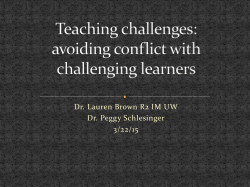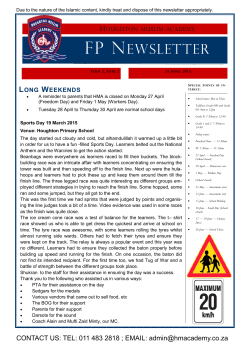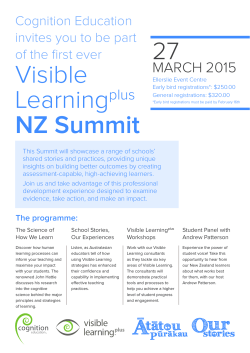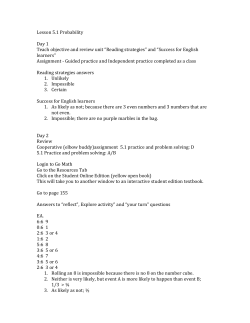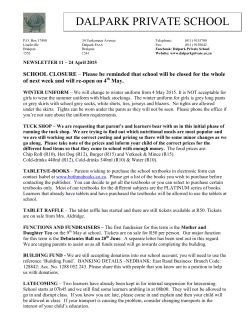
Objective #4
POD —IDEA Center Learning Notes S e p t e m b e r 2 0 0 6 Michael Theall, Youngstown State University, Series Editor IDEA Learning Objective #4: “Developing specific skills, competencies, and points of view needed by professionals in the field most closely related to this course” Nancy McClure, Fairmont State University, nmcclure@fairmontstate.edu Background A professional's skill, competence, and point of view all affect his or her performance in the workplace. When you choose professional service you realize that you want a professional who has it all--skill, competence, and the right point of view or disposition. How do professionals acquire these attributes? According to Wenger (1), learning of this nature involves participation in a community of practice, a term that "…refers not just to local events or engagement in certain activities with certain people, but to a more encompassing process of being active participants in the practices of social communities and constructing identities in relation to these communities" (p. 4). While Lave and Wenger (2) coined the term "community of practice" to provide a framework specific to their observations during a study of various types of apprenticeships, the concept is not new to education. Its roots date back to the early work of Lev Vygotsky, a Russian psychologist who tied cognitive development to culture. Vygotsky set forth the notion that learning is inherently social and is embedded in a particular cultural setting (3). Since then, researchers who study cognition have advanced this idea in the theoretical framework known as situated learning. They generally agree that as time goes on, learners in a community of practice become more able to participate in the group's functions and use its tools. In effect, learners become acculturated, making the norms, behaviors, skills, beliefs, language, and attitudes of their particular community their own (4, 5, 6, 7, 8, 9). Perhaps Clancey (10) says it best: "Learning to become a member of a community of professionals is not accomplished by transferring the rules and handing over the tools. Knowledge of the professional is conceptual, embodied in ways of seeing, roles, ways of interacting. And because concepts are not words, learning cannot be accomplished by describing or telling alone." Fortunately, the task of determining the best ways to help learners become fully functioning members of a community of practice does not rest with the teacher alone. Numerous studies provide direction. In the expanded version of How People Learn, Bransford, Brown, and Cocking (11) focus on research on human learning and the learning potential of all individuals. The research explains the structure of knowledge and identifies eight factors that affect the development of expertise and competent performance. These are paraphrased as follows. • If knowledge is relevant, people can organize it and retain it. • Learners must relate their knowledge to new tasks, making it usable knowledge – the kind experts possess. • Having knowledge that is relevant enables learners to think in terms of problem solving, making inferences, and drawing conclusions. • Knowledge affects the learner's representation of a problem, which can influence the ease with which the learner can solve the problem. • Experts have highly organized knowledge structures related to problem representations • • • resulting in the ability to access and use appropriate knowledge with ease. Since different disciplines have different organizing properties, learners must know both the content and the organization of the subject. The best learners and problem solvers understand the ways in which they learn and are capable of adjusting strategies to meet new needs. They have “metacognitive” skills. Like experts, people in everyday circumstances and in specific contexts operate under social norms and use sets of tools that allow them to perform tasks they might not be able to perform in other situations. Based upon this research on learning, teaching, and learning environments, Bransford et al. propose that learning environments should be learner centered, provide a knowledge-centered environment that makes clear the content, the reasons for learning the content, and the target mastery. These environments should continuously assess student learning (formatively) and embrace a community-centered approach. Helpful Hints To construct a learning environment like the one Bransford and colleagues have proposed, you can follow Weimer's (12) suggestions. She describes a learner-centered environment in terms of five changes in practice that incorporate all of the components proposed by Bransford et al. as well as by the research on communities of practice. The first four changes are summarized here and the fifth change is discussed in the Assessment The first change in practice requires a shift from a perspective that the teacher is in charge of learning to one that teachers and students share the power of learning. When students have a say in their learning, they are more motivated to stay involved with a task (see IDEA Paper #41). For example, having students both set their own high goals and work to achieve them (see POD-IDEA Center Note #15) encourages students to take charge of their learning. The second change in practice relates to content. In the content-centered classroom, teachers "cover" content, and students "acquire" it. In contrast, teachers and students in a learnercentered classroom use content to construct knowledge (3, 13, 14). As a result, students' prior knowledge comes to the fore, students utilize different forms of knowledge, and knowledge construction becomes a social venture (15). When students work to construct knowledge, they acquire an interest in learning more by asking their own questions and seeking answers (IDEA objective 12). A third change in practice centers on the role of the teacher. As mentioned previously, teachers and students share power in a learner-centered classroom. This translates into a redefinition of the teacher's role from provider of information to facilitator, one who helps students interact with content in productive ways. Two of the best ways for a teacher to help students use content productively (i.e., develop the skills, competencies, and dispositions of professionals in the field) are to demonstrate the importance of the subject matter and to relate the course material to real-life situations (see POD-IDEA Center Notes #4 and #11). These two strategies are strongly correlated with achieving IDEA objective 4. Teachers often use authentic problem tasks (16) and case studies to accomplish this objective. A fourth change in practice is a move towards helping the student become a self-directed learner. Students who know and are in control of their cognitive resources, or are metacognitive, are students who are "active, planful learners." Teachers can assist students in becoming more self-directed by displaying a personal interest in them and their learning (see POD-IDEA Center Note #1). Teachers who know students' strengths and weaknesses can work with students on a more personal level to help them utilize their strengths in more productive ways and find ways to transform weaknesses into strengths. In addition, teachers can help students be more independent learners by finding ways to help them answer their own questions (see POD-IDEA Center Note #2). As students learn to take charge of their learning and ask their own questions, teachers have a better understanding of who the student is as a learner and can better direct his or her search for answers. To summarize, students develop the skills, competencies, and points of view needed by professionals by becoming active participants in a learner-centered environment. The teachers and students in that environment form a community of practice where they learn from one another through project- or work-related interpersonal communications, interactions with the environment, and utilization of the tools representative of the group's work. As time goes on, active involvement in the community of practice enhances content learning and helps participants to move from novice toward expert status. Assessment Issues The final change in practice suggested by Weimer (12) is to incorporate a variety of types of assessments and to involve students in self assessment. This change evolves from the revised view of the purpose of evaluation. Whereas evaluation used to be a way to produce grades, the new purpose both generates grades and promotes learning. Based upon this new description of evaluation, traditional assessments (e.g., tests, quizzes, etc., or any instrument on which students choose answers) should be replaced or partnered with alternative assessment techniques such as short-answer questions, essays, performance assessments, demonstrations, portfolios, or any form in which students create responses (17, also see IDEA Papers #16 and #17). When students have the chance to construct responses to a set of specific criteria, the teacher has a greater opportunity not only to see what students are learning, but also to provide criteria-related feedback. This type of feedback promotes deeper learning, particularly when students have the opportunity to reassess and revise their work (see IDEA Papers #39 and #42). The strategies you use to assess students' acquisition of the skills, competencies, and points of view reflect your judgment as a practicing professional. You are the most qualified to know what the expectations are for your profession. Whether you rely on accreditation standards or some other guidelines for your profession, you know the criteria that are important. These criteria will guide your selection of assessment strategies. Once you have determined the specific criteria for skills, competencies, and points of view, you will consider which assessment strategies provide the best picture of your students' attainment of them within your community of practice. (See Walvoord and Anderson (18) to learn more about linking your assessment/grading to learning outcomes.) For example, in teacher education, you want to make sure that your students can plan and teach age-appropriate lessons, manage busy classrooms on a daily basis, and relate well to both children and adults. Engineering students must go beyond mathematical calculations to design workable solutions or products. Aspiring musicians must master music theory, but must also be able to create and perform new works. Future philosophers must know Aristotle, but must also exhibit the habits of thought of the discipline and develop personal philosophies. Ultimately, engaging and assessing your students in the performance of authentic tasks within specific communities of practice helps them construct identities in relation to these communities, and supports their professional growth. References and Resources (1) Wenger, E. (1999). Communities of practice: Learning, meaning and identity. Cambridge: Cambridge University Press. (2) Lave, J., & Wenger, E. (1991). Situated learning: Legitimate peripheral participation. Cambridge: University of Cambridge Press. (3) Vygotsky, L. S. (1993). The collected works of L. S. Vygotsky: Vol.2 (J. Knox & C. Stevens, Trans.) New York: Plenum. (4) Cognition and Technology Group at Vanderbilt. (1990). Anchored instruction and its relations to situated cognition. Educational Researcher, 19(6), 2-10. (5) Cognition and Technology Group at Vanderbilt. (1993). Anchored instruction and situated learning revisited. Educational Technology, 33(3), 52-70. (6) Derry, S. J. (1992). Beyond symbolic processing: Expanding horizons for educational psychology. Journal of Educational Psychology, 84, 413-419. (7) Garrison, J. (1995). Deweyan pragmatism and the epistemology of contemporary social constructivism. American Educational Research Journal, 32, 716-741. (8) Greeno, J. G., Collins, A. M., & Resnick, L. B. (1996). Cognition and learning. In D. Berliner & R. Calfee (Eds.), Handbook of educational psychology (pp. 15-46). New York: McMillan. (9) Smart, J. C., & Feldman, K. A. (1998). Accentuation effects of dissimilar academic departments: An application and exploration of Holland's theory. Research in Higher Education, 39 (4), 385-418. (10) Clancey,W. J. (1995). A tutorial on situated learning. [Electronic version]. In Self, J. (Eds.) Proceedings of the International Conference on Computers and Education (Taiwan) Charlottesville, VA: AACE. Retrieved September 20, 2006, from http://cogprints.org/323/00/139.htm (11) Bransford, J., Brown, A., & Cocking, R. (Eds.). (2000). How people learn: Brain, mind, (12) (13) (14) (15) (16) (17) (18) experience, and school. Washington: National Academy Press. Weimer, M. (2002). Learner-centered teaching. San Francisco: Jossey-Bass. Dewey, J. (1933). How we think. Boston: Heath. Piaget, J. (1997). The moral judgment of the child. New York: Free Press. Leinhardt, G. (1992). What research on learning tells us about teaching. Educational Leadership, 49, 20-25. Hung, D. (2002). Situated cognition and problem-based learning: implications for learning and instruction with technology. Journal of Interactive Learning Research, 13, 393-425. North Central Regional Educational Laboratory. (1997). Alternative assessment. In Critical Issue: Ensuring equity with alternative assessment. Retrieved September 20, 2006, from http://www.ncrel.org/sdrs/areas/issues/method s/assment/as8lk30.htm Walvoord, B. E., & Anderson, V. J. (1998). Effective grading: A tool for learning and assessment. San Francisco: Jossey-Bass Publishers. Related POD-IDEA Center Notes IDEA Item #1 "Displayed a personal interest in students and their learning," Virginia S. Lee IDEA Item #2 "Found ways to help students answer their own questions," Nancy McClure IDEA Item #4 "Demonstrated the importance and significance of the subject matter," Nancy McClure IDEA Item #11 "Related course material to real life situations," Michael Theall IDEA Item #15 "Inspired students to set and achieve goals which really challenged them," Todd Zakrajsek Additional Resources IDEA Paper No. 16: Improving Multiple-Choice Tests, Clegg and Cashin IDEA Paper No. 17: Improving Essay Tests, Cashin IDEA Paper No. 39: Establishing Rapport: Personal Interaction and Learning, Fleming IDEA Paper No. 41: Student Goal Orientation, Motivation, and Learning, Svinicki IDEA Paper No. 42: Integrated Course Design, Fink ©2006 The IDEA Center This document may be reproduced for educational/training activities. Reproduction for publication or sale may be done only with prior written permission of The IDEA Center.
© Copyright 2025


